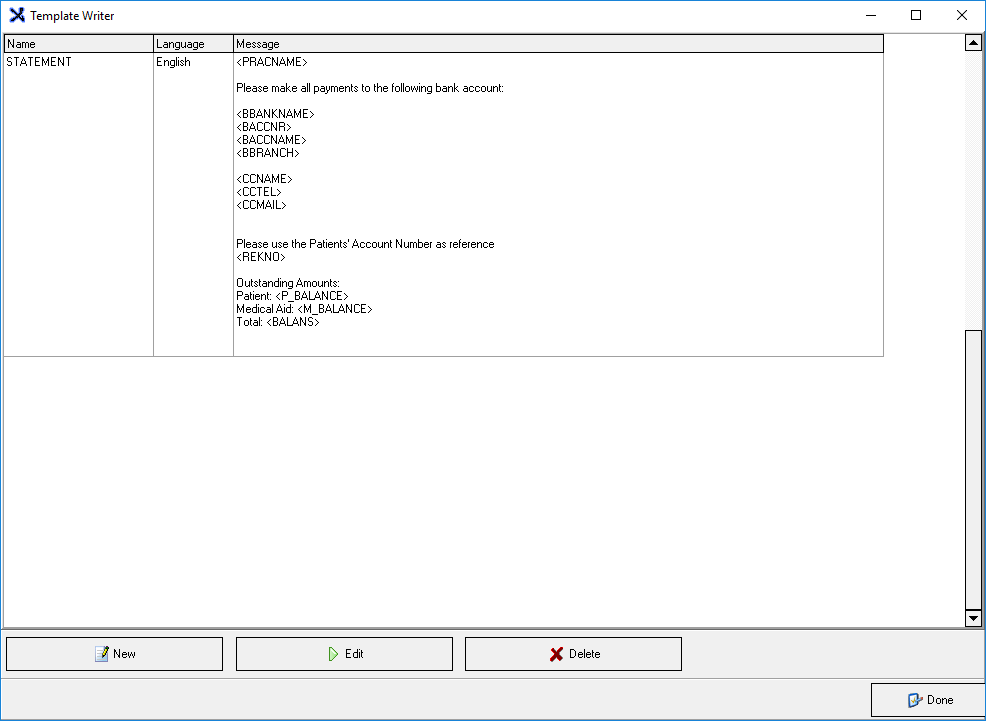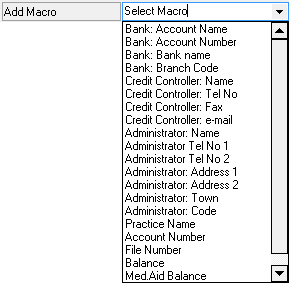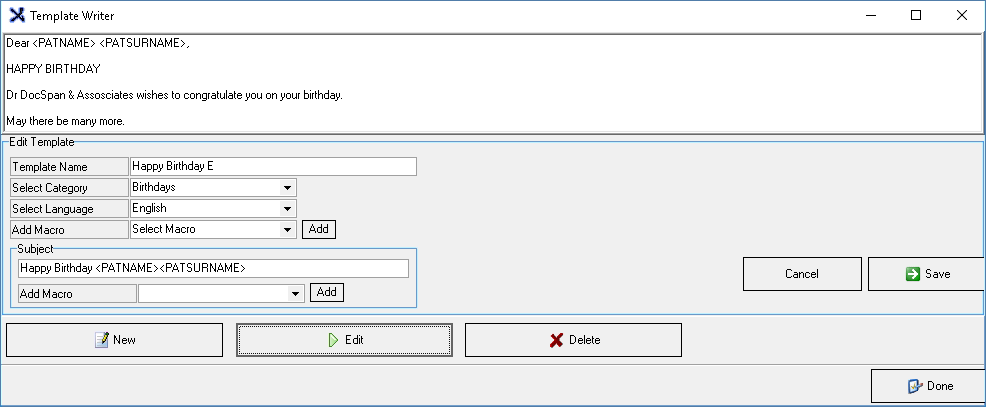Statement Front Page Template
A Statement Front Page is a summary of the Patients' account. A Template is a predesigned layout of the Statement that already includes the framework and structure for the final document. Templates save time and are useful to ensure all documents look uniform.
Placeholders/Macros can be added to a template that will collect pre-filled information from several places in the system. Using Placeholders/Macros eliminates data capturing errors as the user doesn't need to type out the information.
- The contents of this User Manual will consist of the following information:
- New Statement Front Page
- Edit an Existing Statement Front Page
- Delete an Existing Statement Front Page
- Log in to the GoodX Desktop App with your GoodX username and password.
- From the Navigator, Double Click on the GoodX Manage module.

- The GoodX Manager screen will open.

- Click on Global lists on the menubar.

- Click on Statement Front Page Template on the submenu.

- The Template Writer screen will open.

- Templates that have been set up will be listed and the information will be divided into columns:
- Name: The name that has been allocated to the Statement Front Page Template.
- Language: The language used in the content of the Statement Front Page Template.
- Message: The full content of the Statement Front Page Template.
New Statement Front Page Template
The user is able to create a new Statement Front Page Template to use when Statements are sent.- Click on New to set up a new Statement Front Page Template.

- The Template Writer screen will open.

- Text Box: A free text field where the content of the Statement Front Page Template will be written. The text box has no character limit.

- Click on the Textbox to enter the contents of the Statement Front Page Template, use the macros as explained in the Add Macro section of this user manual to pull through certain information from the system when the Statement Front Page Template is sent.

Please Note: Macros that are added will display in <> (brackets) on the template, which represents a placeholder for the information that will be populated when the template is used.
- Edit Template: Allows the user to build and create the Statement Front Page Template.

- Please fill in or select the relevant option for each field:
![]()
- Template Name: A short description of what the Statement Front Page Template is for. This is a single-line text field.
![]()
- Select Language: The language that the Statement Front Page Template will be written in.
Please Note: The user will not be able to change the language that the Template is written in. English is selected by default.

- Add Macro: Allows the user to select preset-up macros to build the content of the Statement Front Page Template. The macros available on the drop-down menu will be determined by the category that is selected. Macros will auto-fill the information relating to the particular patient or debtor. This will customise and personalise the Statement and save time by not having to look up and type out the information. The information will be pulled through from the information that is currently captured on the system.
- Click on the Add Macro drop-down menu to select an appropriate option.

- Select an option from the list that has become available:
- Bank: Account Name: The type of bank account that the practice has, for example, Cheque, Savings, Current etc.
- Bank: Account Number: The account number associated with the bank account of the Practice.
- Bank: Bank name: The banking institution with whom the Practice banks.
- Bank: Branch Code: A unique number that identifies the location of where the bank is situated.
- Credit Controller: Name: The name of the Company or Individual who manages and is responsible for collecting debt and ensuring payments come in on time, at the Practice.
- Credit Controller: Tel No: A telephone number where the Credit Controller can be reached.
- Credit Controller: Fax: A number where facsimile documents can be sent to the Credit Controller by use of a fax machine.
- Credit Controller: e-mail: An address where electronic mail can be sent to the Credit Controller.
- Administrator: Name: The name of the person who administrates the specific account.
- Administrator Tel No 1: A telephone number where the Administrator can be reached.
- Administrator Tel No 2: An alternative contact number where the Administrator can be reached.
- Administrator: Address 1: Street Name/Complex Name and number associated with the physical address of the Administrator.
- Administrator: Address 2: Suburb associated with the physical address of the Administrator.
- Administrator: Town: The name of the town that is associated with the physical address of the Administrator.
- Administrator: Code: A postal code associated with the physical address of the Administrator.
- Practice Name: The name of the Practice that they are trading under.
- Account Number: The unique debtor number that is associated with the Patients Account, for example, DEB11.
- File Number: The file number that has been allocated to the Patients' hardcopy file.
- Balance: The total amount that is currently outstanding.
- Med.Aid Balance: The current amount, for which the Patient's Medical Aid is liable.
- Patient Balance: The amount which the Patient is currently liable for.
- The chosen option will be inserted into the Add Macro field.
![]()
- Click on the Add button next to the selected macro to add it to the textbox.

- Subject: A short description of what the E-mail is about when the Statement Front Page is sent.

- Click on the Subject text field to input a relevant heading for the Statement Front Page, when sent via E-mail.

- Click on the Add Macro drop-down menu to add macros to the subject to personalise and customise the subject of the E-mail.

- Please refer to the Add Macro section in this user manual, for an explanation of how to use the macros.
- Click on Cancel to close the New Template Writer screen without saving the content of the Statement Front Page Template that was created.

- Click on Save to save the content of the Statement Front Page Template that was created. The New Template Writer screen will close and return to the Template Writer screen.

- The newly created Statement Front Page Template will be added to the template list.

Edit an Existing Statement Front Page Template
Allows the user to makes changes to an existing Statement Front Page Template.
- Click on the desired Statement Front Page Template that the user would like to make changes to.

- Click on the Edit button.

- The Template Writer screen of the selected item will open.

- Make the necessary desired changes.
- Click on Cancel to close the New Template Writer screen without saving the changes that were made.

- Click on Save to save the content of the Statement Front Page that was changed. The New Template Writer screen will close and return to the Template Writer screen.

Delete an Existing Statement Front Page Template
Allows the user to delete a Statement Front Page Template when they are no longer going to use the template.
- Click on the desired Statement Front Page Template that the user would like to delete.

- Click on the Delete button.

- A Confirm pop-up will appear to ask whether the user would like to delete the selected Statement Front Page Template.

- Click on the No button to close the pop-up and not delete the selected Statement Front Page Template.

- Click on the Yes button to delete the selected Statement Front Page Template and return to the Template Writer screen.

- Click on the Done button to exit the Template Writer screen and return to the GoodX Manager screen.
